How to Install a Sign and Keep it Plumb
“How to Install a Sign,” you ask, “And keep it plumb?”
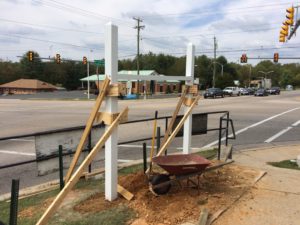 It takes some planning to make and install a large free-standing sign in the ground and install it where everything is relatively level and plumb. Augusta Sign Company makes many of its signs out of wood products. Many times wood signs are installed on wood or metal posts, and many times metal signs are installed within a wood or metal post system. But if you construct a fairly large sign that is going to be mounted relatively high in the air, how do you keep everything level and plumb?
It takes some planning to make and install a large free-standing sign in the ground and install it where everything is relatively level and plumb. Augusta Sign Company makes many of its signs out of wood products. Many times wood signs are installed on wood or metal posts, and many times metal signs are installed within a wood or metal post system. But if you construct a fairly large sign that is going to be mounted relatively high in the air, how do you keep everything level and plumb?
Since I operate a small one-man shop with an occasional helper, I have to keep the fabrication and installation as simple as possible. I aim to assemble the post structures first on the ground, on my shop floor or 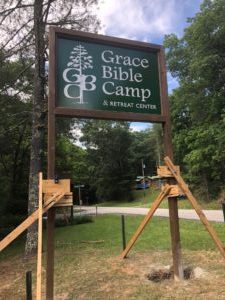 tables, disassemble them, then assemble them again in the field when I know that everything will fit together nice and square. Most of the time the land in which the sign will be erected is not flat, so I have to take into consideration that either one hole will be deeper or one post will be longer to compensate for the difference. Once the holes are dug and the poles are hoisted in place, I attach my own clamping system, one of Augusta Sign Company’s ingenious intellectual properties, that keeps signposts plumb in both directions (forward-to-backward; and side-to-side).
tables, disassemble them, then assemble them again in the field when I know that everything will fit together nice and square. Most of the time the land in which the sign will be erected is not flat, so I have to take into consideration that either one hole will be deeper or one post will be longer to compensate for the difference. Once the holes are dug and the poles are hoisted in place, I attach my own clamping system, one of Augusta Sign Company’s ingenious intellectual properties, that keeps signposts plumb in both directions (forward-to-backward; and side-to-side).
The projects shown below are two examples of how I achieve plumb signs using these special plumbing tools. It makes it possible for one person to install posts quickly. Once the concrete sets and the the bracing is removed, you have a nice straight and level and plumb sign product on display for years to come!
Mark Hackley is the owner of Augusta Sign Company located in Staunton serving Augusta County, Staunton, and Waynesboro, Virginia in the heart of the Shenandoah Valley! 540-943-9818
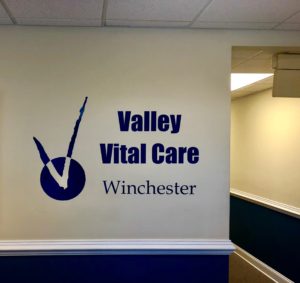 Applying vinyl lettering and logos on interior walls is an easy and relatively inexpensive way to draw attention to your brand as customers enter your organization. A few weeks ago I was hired to do exactly that for a local Waynesboro, Virginia business expanding into Winchester.
Applying vinyl lettering and logos on interior walls is an easy and relatively inexpensive way to draw attention to your brand as customers enter your organization. A few weeks ago I was hired to do exactly that for a local Waynesboro, Virginia business expanding into Winchester.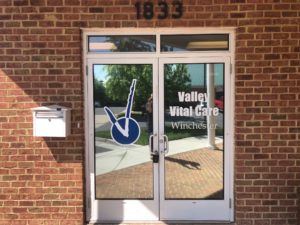 This particular customer has had me incorporate their brand into their fleet of vehicles, their front door and also on their interior entry walls. The benefits of using the same sign company for all your sign branding include: a) colors and typestyles and proportions are consistent across the various places you post your branding signage; b) you have a good idea on upcoming costs when budgeting your sign marketing for new offices, or new vehicles; c) if a sign or letter gets damaged in the future for some reason, you have a source of the original design artwork used to cut your designs, saving a lot of time and potential cost in repairs and maintenance.
This particular customer has had me incorporate their brand into their fleet of vehicles, their front door and also on their interior entry walls. The benefits of using the same sign company for all your sign branding include: a) colors and typestyles and proportions are consistent across the various places you post your branding signage; b) you have a good idea on upcoming costs when budgeting your sign marketing for new offices, or new vehicles; c) if a sign or letter gets damaged in the future for some reason, you have a source of the original design artwork used to cut your designs, saving a lot of time and potential cost in repairs and maintenance.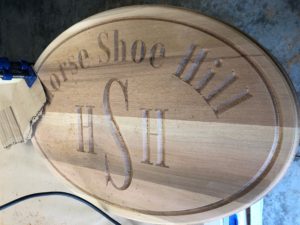 Applying Gold Leaf to Carved Signs
Applying Gold Leaf to Carved Signs presented my proposal, she elected to go for the gold! Gold leaf is an ancient art form. “The Temple of Solomon was profusely gilt,” says Homer in his early writings. Gold leaf was widely used in old Roman art, architecture, furniture, and carved lettering. Gold leaf is actual gold that is beaten down to a fine sheet and applied to surfaces with “size”, a special type of “glue” that the thin metal sheets stick to. To make the sign for the horse farm, I first ordered the cedar panel and had the letters and borders CNC-routed from my customer-approved design. Once the letters and borders were carved, I sanded them with fine-grit sandpaper to smooth out any course grain in the lettering. Once sanded, I cleaned and primed the entire two-sided sign with a quality oil-based primer that seals the wood and provides an adequate base for the finish coat, which in this case was a brush-painted Hunter Green sign enamel. It helps to tint your primer to the shade of your finish coat, so I added some black tint to make a gray primer coat. I use the 2-2-2 method in my finishing of wood signs: 2 coats primer, 2 coats background finish, and 2 coats for the graphics, which for this project meant two passes of gilding to catch any missed areas and pinholes.
presented my proposal, she elected to go for the gold! Gold leaf is an ancient art form. “The Temple of Solomon was profusely gilt,” says Homer in his early writings. Gold leaf was widely used in old Roman art, architecture, furniture, and carved lettering. Gold leaf is actual gold that is beaten down to a fine sheet and applied to surfaces with “size”, a special type of “glue” that the thin metal sheets stick to. To make the sign for the horse farm, I first ordered the cedar panel and had the letters and borders CNC-routed from my customer-approved design. Once the letters and borders were carved, I sanded them with fine-grit sandpaper to smooth out any course grain in the lettering. Once sanded, I cleaned and primed the entire two-sided sign with a quality oil-based primer that seals the wood and provides an adequate base for the finish coat, which in this case was a brush-painted Hunter Green sign enamel. It helps to tint your primer to the shade of your finish coat, so I added some black tint to make a gray primer coat. I use the 2-2-2 method in my finishing of wood signs: 2 coats primer, 2 coats background finish, and 2 coats for the graphics, which for this project meant two passes of gilding to catch any missed areas and pinholes.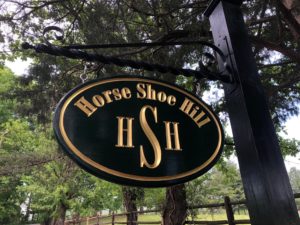 Once the gold was applied and cured for several days, I burnished it with a cotton ball and completely waxed the entire sign using Nu-Finish synthetic auto wax, available in most auto parts stores. The post was constructed from a 6″ X 6″ X 13′ long Southern Yellow Pine column with a beefed-up area at the bottom of the post, suggested by my customer’s architect. The sign post was colored black to match the black iron scroll bracket, which was a stock item from my supplier. I used stainless steel eye-bolts and quick links to attach the sign to the bracket. The sign was planted in a 3 foot deep hole and surrounded with fast set concrete.
Once the gold was applied and cured for several days, I burnished it with a cotton ball and completely waxed the entire sign using Nu-Finish synthetic auto wax, available in most auto parts stores. The post was constructed from a 6″ X 6″ X 13′ long Southern Yellow Pine column with a beefed-up area at the bottom of the post, suggested by my customer’s architect. The sign post was colored black to match the black iron scroll bracket, which was a stock item from my supplier. I used stainless steel eye-bolts and quick links to attach the sign to the bracket. The sign was planted in a 3 foot deep hole and surrounded with fast set concrete.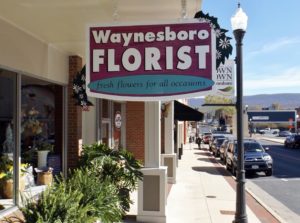 Virginia only has seven cities with populations in six figures. Most of it’s cities and towns fall between about 5,000-75,000, with about 10 over and about 120 under. Most of the towns in the Shenandoah Valley, where my shop is located, are perfect places to hang interesting, hand-painted wood signs. And it so happens those are exactly the types of signs I make in my shop near Staunton, Virginia!!
Virginia only has seven cities with populations in six figures. Most of it’s cities and towns fall between about 5,000-75,000, with about 10 over and about 120 under. Most of the towns in the Shenandoah Valley, where my shop is located, are perfect places to hang interesting, hand-painted wood signs. And it so happens those are exactly the types of signs I make in my shop near Staunton, Virginia!!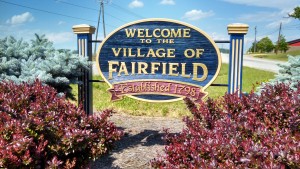 adhered to the flat surface, then wherever the stencil does not cover the wood, it is blasted away using a high-pressure sand gun. Various size nozzles are used for different effects. After blasting, the signs are stained with a high-quality, durable solid-color oil stain, then hand-lettered. These signs are very long-lasting and can be easily maintained with scheduled periodic annual cleaning and refresher coats of paint every decade. The sign pictured above for Waynesboro Florist was put into service in the mid-1990’s and is still looking great with only one
adhered to the flat surface, then wherever the stencil does not cover the wood, it is blasted away using a high-pressure sand gun. Various size nozzles are used for different effects. After blasting, the signs are stained with a high-quality, durable solid-color oil stain, then hand-lettered. These signs are very long-lasting and can be easily maintained with scheduled periodic annual cleaning and refresher coats of paint every decade. The sign pictured above for Waynesboro Florist was put into service in the mid-1990’s and is still looking great with only one 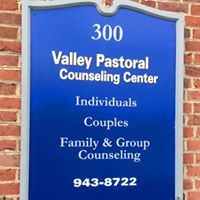 maintenance call a few years ago, where I rehabbed the fading paint.
maintenance call a few years ago, where I rehabbed the fading paint.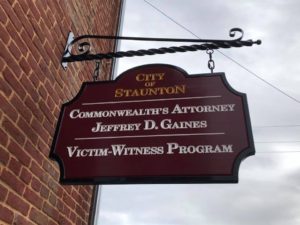 Hanging the signs is usually accomplished using iron scroll brackets and chain with hooks. There are several standard bracket types in use, and brackets can also be customized for a much higher investment. Probably one of the biggest things to remember about quality wood signs is their regular maintenance. Just as a great musician would tune her piano on a regular basis to ensure good quality sound, a great business owner would clean, re-stain, and repaint her sign periodically. The rule of thumb for signs manufactured by Augusta Sign Company is every about 5-10 years. The cedar and redwood and mahogany boards themselves will last a lifetime with no maintenance, but the branding that is painted on the signs will have to be periodically refreshed to keep up a positive image.
Hanging the signs is usually accomplished using iron scroll brackets and chain with hooks. There are several standard bracket types in use, and brackets can also be customized for a much higher investment. Probably one of the biggest things to remember about quality wood signs is their regular maintenance. Just as a great musician would tune her piano on a regular basis to ensure good quality sound, a great business owner would clean, re-stain, and repaint her sign periodically. The rule of thumb for signs manufactured by Augusta Sign Company is every about 5-10 years. The cedar and redwood and mahogany boards themselves will last a lifetime with no maintenance, but the branding that is painted on the signs will have to be periodically refreshed to keep up a positive image.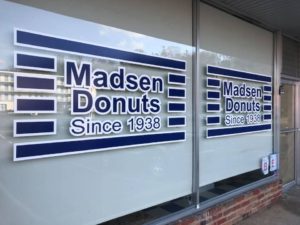 Call Mark Hackley, founder of Tree Street Signs that later became Augusta Sign Company for all your downtown signage needs. Not only can he help you with wood identification signs, but also door and window lettering, wall lettering, banners, and other temporary advertising signs like sandwich boards that you’d use in marketing your awesome downtown shop. He can be reached at 540-943-9818.
Call Mark Hackley, founder of Tree Street Signs that later became Augusta Sign Company for all your downtown signage needs. Not only can he help you with wood identification signs, but also door and window lettering, wall lettering, banners, and other temporary advertising signs like sandwich boards that you’d use in marketing your awesome downtown shop. He can be reached at 540-943-9818.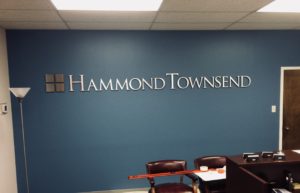 interior, there is an assortment of materials you can use that are potentially less expensive than those that have to withstand the elements for many seasons.
interior, there is an assortment of materials you can use that are potentially less expensive than those that have to withstand the elements for many seasons. recommended for exterior applications. The particular style used had black edges and brushed silver laminated metal faces. They were stud mounted with spacers to cast a nice shadow from the office lighting. The customer painted the accent wall themselves and the rich blue background really sets off the lettering and makes for a very eye-catching branding statement!
recommended for exterior applications. The particular style used had black edges and brushed silver laminated metal faces. They were stud mounted with spacers to cast a nice shadow from the office lighting. The customer painted the accent wall themselves and the rich blue background really sets off the lettering and makes for a very eye-catching branding statement! THE GREAT OUTDOORS
THE GREAT OUTDOORS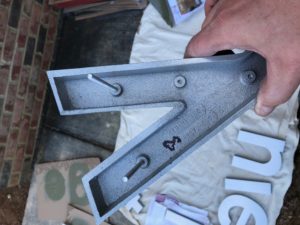 show how your letters will look an the wall? Do they provide final proofs for approval prior to production? What is their turn-around time? All Gemini letters and plaques come with a lifetime guarantee, another good reason to specify the Gemini brand, as do many architects.
show how your letters will look an the wall? Do they provide final proofs for approval prior to production? What is their turn-around time? All Gemini letters and plaques come with a lifetime guarantee, another good reason to specify the Gemini brand, as do many architects.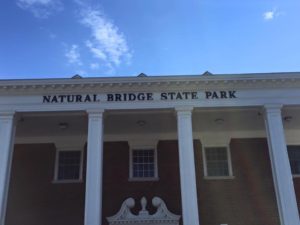 The most common options for exterior wall letters: Cast aluminum or bronze with natural satin finished or cast aluminum with painted finishes; Cut out aluminum with either natural or painted finishes; Cut out acrylic letters with painted finishes. All these types of letters are the best for walls.
The most common options for exterior wall letters: Cast aluminum or bronze with natural satin finished or cast aluminum with painted finishes; Cut out aluminum with either natural or painted finishes; Cut out acrylic letters with painted finishes. All these types of letters are the best for walls.